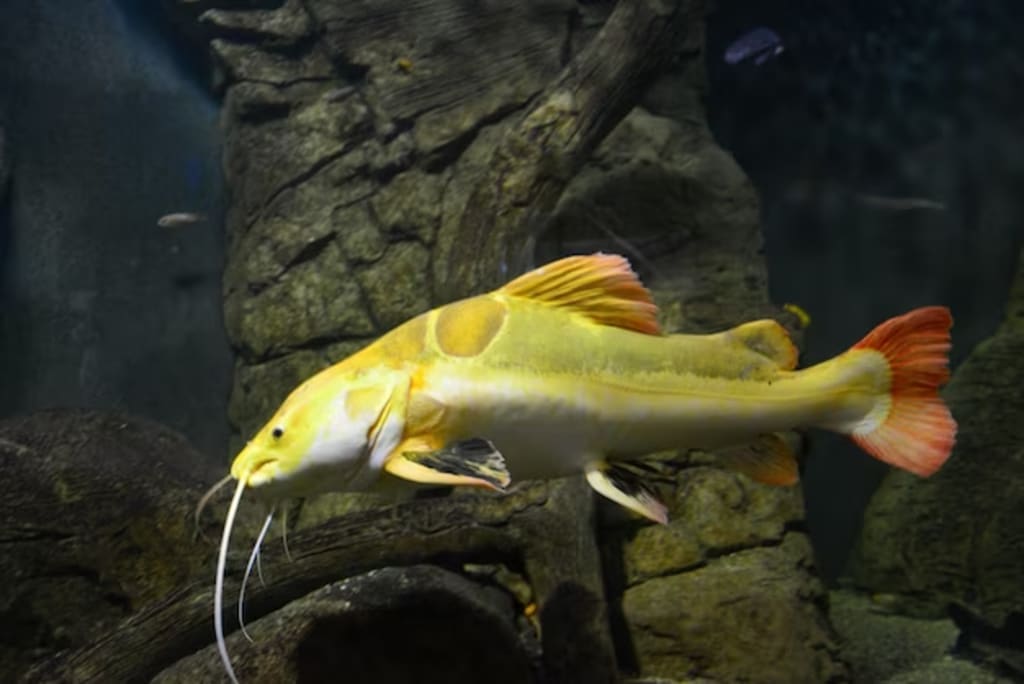Exploring the Yellow-Tail Catfish: A Fascinating Freshwater Predator
"Unveiling the Enigmatic World of the Yellow-Tail Catfish"

The yellow-tail catfish, scientifically known as Pelteobagrus fulvidraco, is an intriguing species of freshwater fish that inhabits rivers and lakes across Asia. This remarkable fish species possesses unique characteristics, exhibits fascinating behaviors, and holds significant ecological importance within its native habitats. In this essay, we will delve into the distinctive features, predatory nature, and ecological role of the yellow-tail catfish, shedding light on its significance in freshwater ecosystems.
Physical Characteristics and Habitat
The yellow-tail catfish boasts a striking appearance, characterized by its elongated body, yellowish-brown coloration, and distinctive yellow caudal fin, from which it derives its name. This visually captivating fish also features prominent barbels around its mouth, aiding in prey detection and environmental navigation. These physical attributes contribute to the yellow-tail catfish's adaptability and success in its freshwater habitats.
In its natural environment, the yellow-tail catfish is predominantly found in slow-moving rivers, lakes, and reservoirs across East Asia, including regions of China, Korea, and Japan. These freshwater ecosystems provide the necessary conditions for the species to thrive, offering ample prey, shelter, and suitable breeding grounds. The adaptability of the yellow-tail catfish allows it to inhabit a variety of aquatic environments, contributing to its widespread distribution within its native range.
Behavior and Predatory Nature
The enigmatic nature of the yellow-tail catfish serves as a reminder of the intricate balance and diversity present within freshwater ecosystems, highlighting the need for conservation efforts to protect this remarkable species and its habitat.The yellow-tail catfish is renowned for its predatory prowess and voracious appetite, positioning it as a formidable predator within its aquatic domain. As an opportunistic feeder, it preys on a diverse array of aquatic organisms, including small fish, crustaceans, and insect larvae. Its streamlined body and powerful fins enable swift movement through the water, facilitating precise and agile pursuit of prey.
Furthermore, the yellow-tail catfish exhibits nocturnal behavior, often engaging in hunting activities under the cover of darkness. This adaptation allows it to take advantage of reduced visibility and heightened prey activity during nighttime hours. By employing stealth and ambush tactics, the yellow-tail catfish effectively secures its place as a top predator within its freshwater habitats.
Ecological Significance and Conservation
The yellow-tail catfish plays a crucial role in regulating the population dynamics of other species within freshwater ecosystems. As a predator, it helps control the numbers of smaller fish and invertebrates, contributing to the overall balance and health of the ecosystem. By exerting predation pressure on prey populations, the yellow-tail catfish indirectly influences the distribution and abundance of various aquatic organisms, shaping the ecological dynamics of its habitat.
Despite its ecological significance, the yellow-tail catfish faces conservation challenges, including habitat degradation, pollution, overfishing, and the introduction of non-native species. These threats have led to population declines in some regions, necessitating focused conservation efforts to ensure the species' long-term survival.
Conservation initiatives aimed at preserving the habitats of the yellow-tail catfish are essential for safeguarding its populations and the overall health of freshwater ecosystems. Habitat restoration, sustainable fishing practices, and the establishment of protected areas are critical components of conservation strategies aimed at mitigating the threats faced by the yellow-tail catfish and promoting the preservation of its natural habitats.
In conclusion, the yellow-tail catfish stands as a captivating example of the intricate web of life within freshwater ecosystems. Its unique characteristics, predatory behavior, and ecological significance underscore the importance of protecting the health and integrity of freshwater habitats. By understanding and appreciating the role of the yellow-tail catfish, we can work towards preserving its natural environment and contributing to the conservation of the rich biodiversity found within freshwater ecosystems.
About the Creator
Najaf Abbas
Passionate essay writer dedicated to crafting compelling narratives that engage and enlighten. Specializing in diverse topics, I aim to spark meaningful conversations and inspire appreciation for the world.






Comments
There are no comments for this story
Be the first to respond and start the conversation.